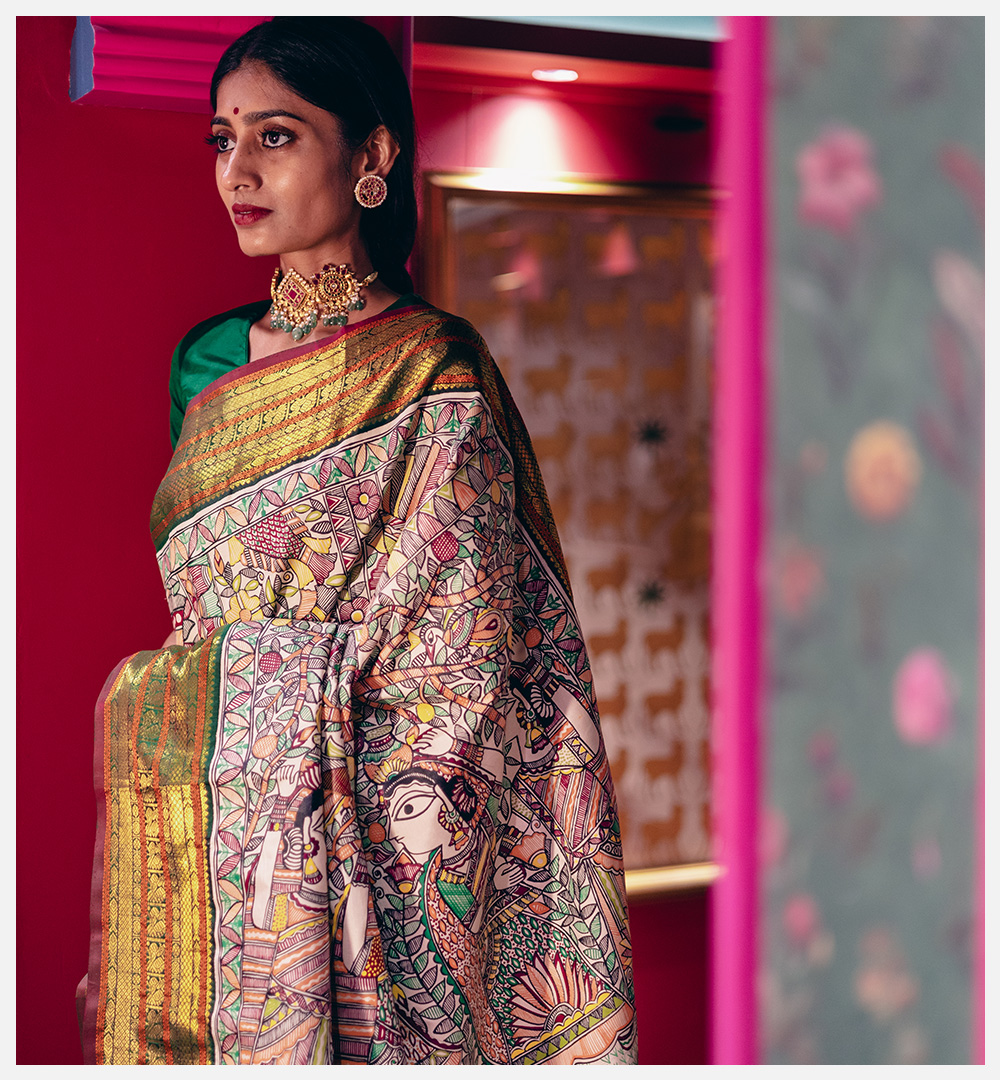Madhubani Art on Sarees - The Heritage Continues
The ultimate representation of elegance, femininity, and heritage, sarees have withstood the tides of time and are adorned even today in uncountable types, vibrant colours, and second-look-guaranteed styles. Among the umpteen art forms that feature on saree drapes, Madhubani stands out as a scintillating choice. Traced back to the Mithila region of Bihar, this ancient art form is intricately woven into the fabric of sarees and shows up as a beguiling amalgamation of expert artisan work and exquisite weaving.
A Brief History of Madhubani Time
The Ramayana forms the roots of Madhubani paintings, and multitudes of scriptures evidence this. Literally translating to “forest of honey”, Madhubani symbolises the abundance bestowed by nature and the prosperity of the Mithila region. In the olden days, women primarily created these paintings, skilfully using natural dyes and pigments to portray scenes from mythology, nature, and their everyday activities at home and outside. Now Madhubani art has grown leaps and bounds, from walls on houses and dilapidated huts to internationally acclaimed paintings and prints on sarees. The year 2007 saw these quaint paintings being bestowed the coveted Geographical Indication (GI) tag, an important acknowledgement of their cultural noteworthiness and copyrighting.
The Saree Launchpad
Madhubani paintings are characterised by their bold lines, ravishing hues, and multifarious designs. As the art form made its way onto sarees, the motifs depicting flora, fauna, and tales became the muses on wearable canvases. These paintings lend an air of regality and mystique to the sarees; so much so, that Madhubani sarees are super-carefully curated by saree houses like Tulsi Madras to become a launchpad for hardworking artisans to express their talent and artwork. These sarees cleanly complement the art form with the richness of Indian textiles, creating a harmonious blend.
Keeping the Connection Going
When Madhubani art fused into sarees, it was not just a casual juxtaposition. It was a well-thought-out integration of art, culture, and tradition. By draping herself in a Madhubani-painted saree, a woman carries with her a piece of legacy or a yesteryear story that needs telling through silk, or even a colourful symbol of her cultural identity. Mithila’s artistic wonders often become heirlooms when married with silk sarees. Madhubani sarees are worn, cherished, and passed down through generations. Patterns that extoll tales about affection, devotion, love, strength, and valour are often the themes of Madhubani-painted sarees.
Modern Day Significance
As sarees have meta-morphed in style over the decades, so have the types of brushwork that artisans have been pulling off. These days, fashionistas, celebrities, and art-cum-saree connoisseurs are always looking out for that gem of a Madhubani saree that can turn eyes faster than a camera’s click. More contemporary designs such as Madhubani motifs with modern silhouettes have made these sarees accessible to broader audiences. Going beyond aesthetics, Madhubani art reinforces a sense of pride in the cultural heritage of the region, the state, and the country. Saree makers like Tulsi Madras encourage the preservation of this venerated art form by providing economic opportunities to adroit artisans and ensuring the continuity of the craft.
Art at Tulsi Madras
Madhubanis are mesmerising. Embrace the soulful fables of the past, find artistic brilliance in the expression through designs and motifs, and always remember to keep the essence of our saree-wearing traditions through Madhubani sarees. Whether you think of Kanchipuram silk sarees, Tussar silk sarees, or Cottons, Madhubani prints are a sight to behold and hold on to. Check out the fantabulous collection of these artful beauties from here!


